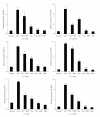Amelioration of glucolipotoxicity-induced endoplasmic reticulum stress by a "chemical chaperone" in human THP-1 monocytes
- PMID: 22550476
- PMCID: PMC3328920
- DOI: 10.1155/2012/356487
Amelioration of glucolipotoxicity-induced endoplasmic reticulum stress by a "chemical chaperone" in human THP-1 monocytes
Abstract
Chronic ER stress is emerging as a trigger that imbalances a number of systemic and arterial-wall factors and promote atherosclerosis. Macrophage apoptosis within advanced atherosclerotic lesions is also known to increase the risk of atherothrombotic disease. We hypothesize that glucolipotoxicity might mediate monocyte activation and apoptosis through ER stress. Therefore, the aims of this study are (a) to investigate whether glucolipotoxicity could impose ER stress and apoptosis in THP-1 human monocytes and (b) to investigate whether 4-Phenyl butyric acid (PBA), a chemical chaperone could resist the glucolipotoxicity-induced ER stress and apoptosis. Cells subjected to either glucolipotoxicity or tunicamycin exhibited increased ROS generation, gene and protein (PERK, GRP-78, IRE1α, and CHOP) expression of ER stress markers. In addition, these cells showed increased TRPC-6 channel expression and apoptosis as revealed by DNA damage and increased caspase-3 activity. While glucolipotoxicity/tunicamycin increased oxidative stress, ER stress, mRNA expression of TRPC-6, and programmed the THP-1 monocytes towards apoptosis, all these molecular perturbations were resisted by PBA. Since ER stress is one of the underlying causes of monocyte dysfunction in diabetes and atherosclerosis, our study emphasize that chemical chaperones such as PBA could alleviate ER stress and have potential to become novel therapeutics.
Figures





References
-
- Khaw KT, Wareham N, Bingham S, Luben R, Welch A, Day N. Association of hemoglobin A1c with cardiovascular disease and mortality in adults: the European prospective investigation into cancer in Norfolk. Annals of Internal Medicine. 2004;141(6):413–420. - PubMed
-
- Binder CJ, Chang MK, Shaw PX, et al. Innate and acquired immunity in atherogenesis. Nature Medicine. 2002;8(11):1218–1226. - PubMed
-
- Ron D, Walter P. Signal integration in the endoplasmic reticulum unfolded protein response. Nature Reviews Molecular Cell Biology. 2007;8(7):519–529. - PubMed
-
- Eizirik DL, Cardozo AK, Cnop M. The role for endoplasmic reticulum stress in diabetes mellitus. Endocrine Reviews. 2008;29(1):42–61. - PubMed
Publication types
MeSH terms
Substances
LinkOut - more resources
Full Text Sources
Research Materials
Miscellaneous
